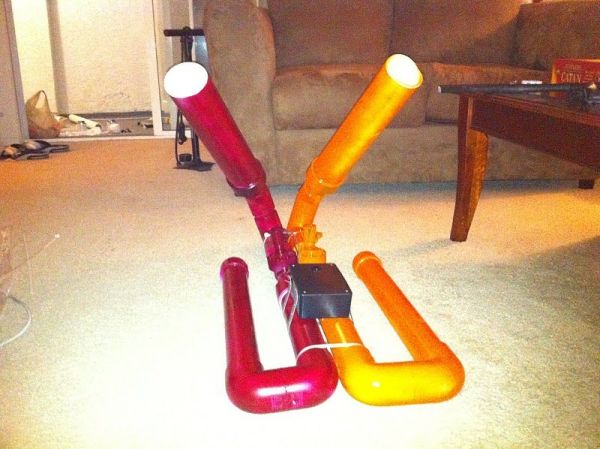Every summer, Qualcomm hosts a Battle of the Schools competition, which gives employees the opportunity to represent their home universities. This year, entries were to be homemade contraptions, and they were judged according to how cool they were perceived to be. Virginia Tech’s cannon project tied the University of Michigan for first place.

The project entailed a pneumatic cannon with valves controlled electronically. When the cannon electronics receive a certain message over Bluetooth, the appropriate barrel fires. On the other side, an Android app uses the phone’s Bluetooth modem to send messages to the cannon. This approach allows the cannon to be fired from around a 30-foot range, line-of-sight.
We started the project on a Friday night and finished the bulk of by Saturday night. We worked pretty much non-stop, and all had experience working on this kind of stuff. With that said, we’d recommend carving out a whole week if you’re working on this by yourself. So now that you’re enticed beyond your wildest imagination, let’s get started.
Please remember to be safe while building and using this device. You are entirely responsible for what you do with this information.
Step 1: Shopping List
Here’s a list of all the parts you’ll need:
Arduino Uno (1x, $29.95 each)
BlueSmirf Silver Bluetooth Modem (1x, $39.95 each)
Male Break Away Headers (1x, $2.95 each)
Solid Hookup Wire (1x, $10.95 each)
150-psi Inline Sprinkler Valve (2, $11.99 each)
Bicycle Tire Inner Tube (2x, $3.99 each)
6″ x 4″ x 2″ Project Box (1x, $5.29 each)
SPST Relay (2x, $3.19 each)
Breadboard-Style Prototyping Board (1x, $2.19 each)
2″ Diameter PVC
3″ Diameter PVC
1″ Diameter PVC
2″ PVC Endcap
2″ PVC Elbow
2″ Coupler
3″ to 2″ Reducer Bushing
1″ Schedule 40 PVC Adapter
3″ to 2″ PVC Adapter Coupler
2″ 45 degree PVC Coupler
Plastic Epoxy
PVC Primer and Cement
You’ll also need some tools:
Soldering iron with solder
Safety goggles
Ear plugs
Solder sucker (unless you’re really good)
Drill
Wire strippers
Flush cutters (optional, for a professional finish)
Heat gun and heatshrink tubing (optional, for a more durable finish)
Also, please note that you can get ranges up to 350 feet if you are willing to spend an extra $25 on a Bluetooth modem, assuming your phone’s hardware also supports that range. The BlueSmirf Gold is also available from SparkFun with a very similar interface. Please note, however, that the pin order is slightly different between the silver and gold models. It shouldn’t be too bad to convert from one to the other though.
Step 2: Hardware is Red, Software is Blue…
We built a cannon, and so can you!
If you like block diagrams, you can think of our project like this.
Step 3: Build The Cannon
**Safety Note: PVC is not designed to be used with air pressure. If the PVC is damaged and air pressure is applied, the PVC can explode releasing shrapnel. For this project, we would recommend using a tank designed to hold air pressure. If you use PVC, you do so at your own risk**
Pressure Tank:
On these tanks we used bicycle inner tubes with Presta valves. Presta valves were chosen primarily because we already had a good bike pump designed to use Presta valves, however, the locknut they include also makes it easier to secure them when building the tank.
1. Drill a 1/4″ hole in the center of the 2″ PVC end cap.
2. Cut out the valve from the bicycle inner tube. Cut the tube so a 1 1/2″ diameter rubber circle remains around the valve.
3. Apply plastic epoxy to the rubber around the valve, and to the inside of the endcap.
4. Push the valve through the hole you drilled in the end cap, with the valve pointing away from the end which will be glued to the pipe. Make sure the epoxy forms a good seal the whole way around the rubber.
5. Ensure that there is no epoxy on the screw at the top of the Presta valve.
6. Try to get epoxy into the drilled hole, between the PVC and the threads on the valve.
7. Screw down the Presta locknut, holding the valve in place while the epoxy cures.
Once the valve is installed, you can begin building the cannon.
Arduino Uno (1x, $29.95 each)
BlueSmirf Silver Bluetooth Modem (1x, $39.95 each)
Male Break Away Headers (1x, $2.95 each)
Solid Hookup Wire (1x, $10.95 each)
150-psi Inline Sprinkler Valve (2, $11.99 each)
Bicycle Tire Inner Tube (2x, $3.99 each)
6″ x 4″ x 2″ Project Box (1x, $5.29 each)
SPST Relay (2x, $3.19 each)
Breadboard-Style Prototyping Board (1x, $2.19 each)
2″ Diameter PVC
3″ Diameter PVC
1″ Diameter PVC
2″ PVC Endcap
2″ PVC Elbow
2″ Coupler
3″ to 2″ Reducer Bushing
1″ Schedule 40 PVC Adapter
3″ to 2″ PVC Adapter Coupler
2″ 45 degree PVC Coupler
Plastic Epoxy
PVC Primer and Cement
You’ll also need some tools:
Soldering iron with solder
Safety goggles
Ear plugs
Solder sucker (unless you’re really good)
Drill
Wire strippers
Flush cutters (optional, for a professional finish)
Heat gun and heatshrink tubing (optional, for a more durable finish)
Also, please note that you can get ranges up to 350 feet if you are willing to spend an extra $25 on a Bluetooth modem, assuming your phone’s hardware also supports that range. The BlueSmirf Gold is also available from SparkFun with a very similar interface. Please note, however, that the pin order is slightly different between the silver and gold models. It shouldn’t be too bad to convert from one to the other though.
For more detail: Android-Controlled Pneumatic Cannon Powered By Arduino
